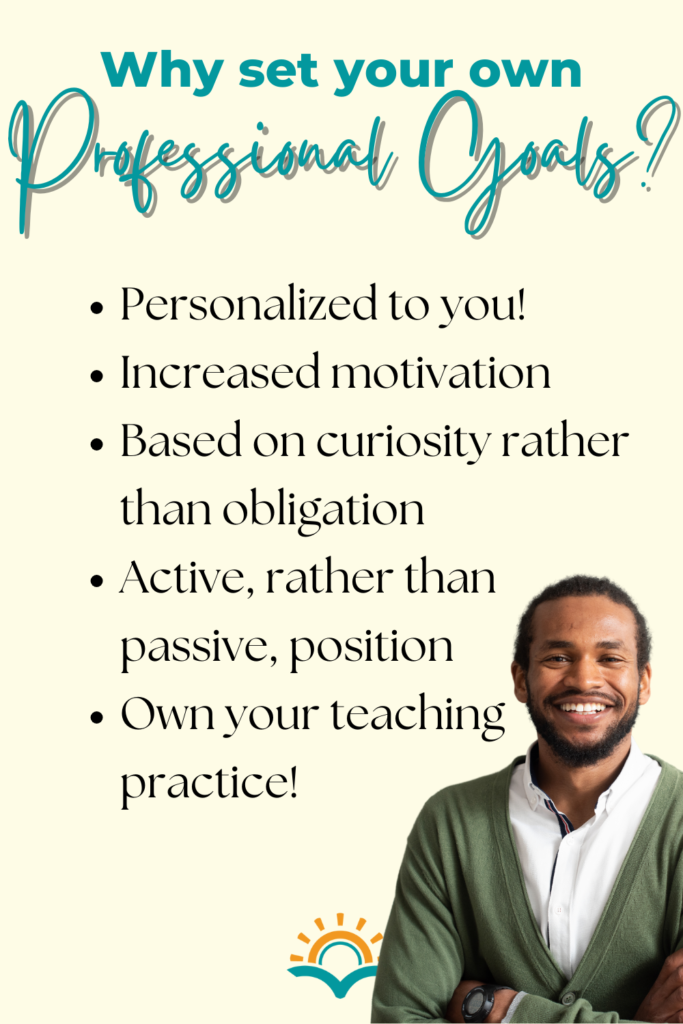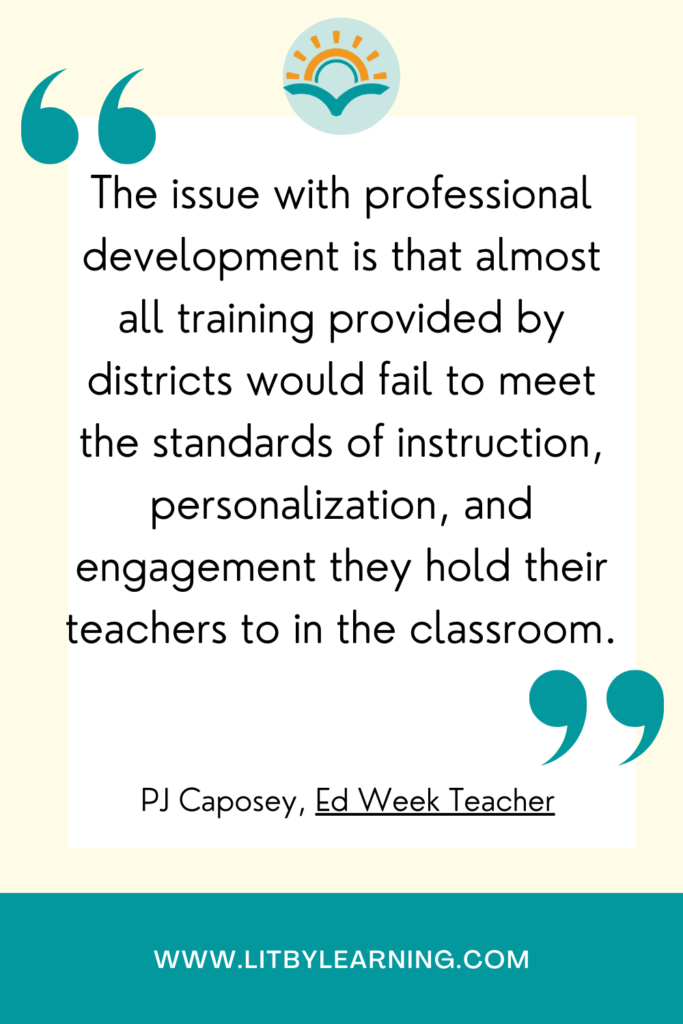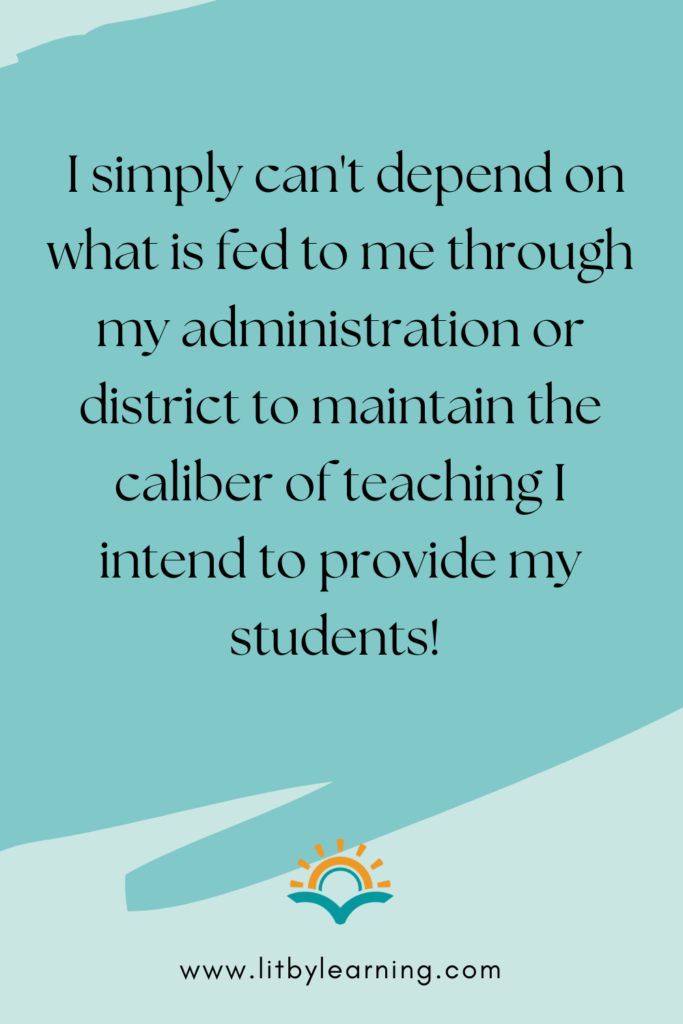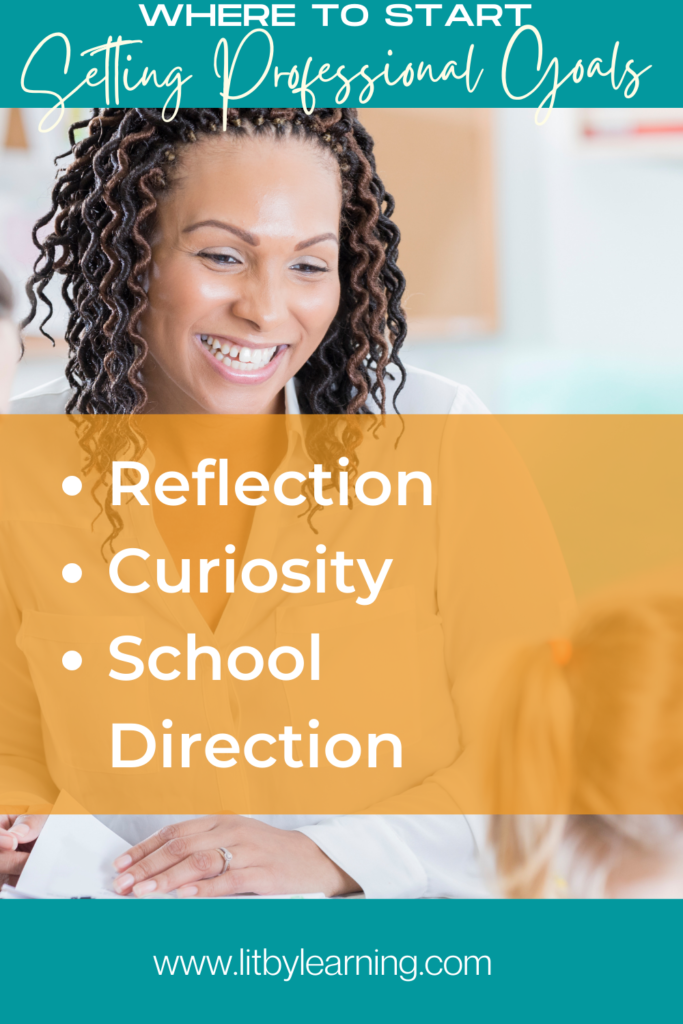As we head back to school this fall, teachers have many mixed feelings about upcoming professional development. Will it be relevant to their context? Will it simply be similar concepts with rebranding?
Throughout my career as an educator, it’s been so important for me to set professional goals for myself. I simply can’t depend on what is fed to me through my administration or district to maintain the caliber of teaching I intend to provide my students! I need to take my development into my own hands!
If you, like me, are tired of leaving your education professional development to chance, check out these ideas for how to set professional goals that will invigorate you this school year!

Why should you set professional goals?
Why should you set your own professional goals as a teacher? Simply put: because it’s what we’d want our own students to do! Think about it: does your ideal student learn passively, simply absorbing whatever you’ve decided to pass down to them that day? Or do they take ownership of their own learning: look for deep connections, determine their next steps, and constantly revise their questions? I know which type of learner I’d love to cultivate in my classroom!
I believe teachers should model this type of active learning in both their personal hobbies and in their professional goals! After all, how much more inspiring is it to work towards your own targets, not just those others have set for you?!

Why is it difficult to set professional goals in teaching?
The biggest barriers to educators setting their own professional goals are time and energy. Heaven knows teachers are responsible for thousands of tasks daily – who has time to focus on themselves and their own development? It can seem that there’s simply not enough time in the day!
That said, I’ve found that this is an area where just a bit of forethought and planning can pay off in dividends throughout the course of a school year. By thinking about my own professional goals before the chaos of the school year begins, I can set a trajectory of inquiry and study that will energize me all year long.

An experimental, inquisitive mindset
I don’t know about you, but I often feel like my job as a teacher is to have the answers. For parents. For students. That said, the more that I’ve grown in my practice, the more I’ve realized that that perspective is limiting and unfair to me and those around me.
It was through my year working in Action Research that I discovered the utility of adopting an inquiry mindset with my professional goals. Instead of saying, “I will make sure I ______,” I try to pose my goals as questions I’m genuinely curious about: “What would happen if I added this routine each day?” or “How will students’ parents respond if I incorporate more parent education into my weekly emails?”
This mindset helps me remain flexible as the year progresses: I can tweak variables and be observant about the results. It also helps me maintain a growth mindset as I pursue my goals!

Where to start in setting professional goals as a teacher
Start with reflection!
The most natural place to start when setting professional goals is with an honest, comprehensive reflection, usually centered on your most recent teacher experience. It’s helpful to look back and consider what went really well, places where problems arose, and concepts you would like to learn more about.
While reflection is great at any time, I especially like to set aside time as a school year ends and just before it begins to consider the big picture.

Set professional goals: start with feedback
Another place to start when you set professional goals as a teacher is with feedback. Be it through an administrative evaluation, a caregiver survey or a partnership with a colleague, considering others’ input on your teaching can be a strategic place to begin setting your intentions for the year. Don’t forget to also take into account students’ feedback when considering a new goal!
Here’s the catch: the feedback you choose to use as a base needs to be meaningful. It needs to be from a source you trust: someone whose mindset aligns with yours, someone you trust and respect. It’s meaningless to set goals based on an evaluation you thought was unfair or incomplete. You need your goals to be motivating to you!
Start with school direction
A third way to begin setting professional goals is to align with what your school or district is working to improve. Perhaps your school is considering switching to a dual language model, so you want to further educate yourself about what that would entail. Or perhaps you’re a teacher just starting at an IB (International Baccalaureate) School, so you want to be intentional about developing your understanding of the model.
A clear advantage of aligning your professional goals with those of your school or district is that, hopefully, already-plannedPD sessions throughout the year will be relevant. Coworkers in your school will already be talking about your learning, so there will likely be increased opportunities for collaboration or peer observation.
If you choose this as your starting point, I still highly recommend personalizing your goals to you. What additional books or journals could you seek out? What will this look like in your classroom? Even with a shared goal, it’s critical to make your action steps specific to you.

Examples of professional goals I’ve set each academic year
Throughout my career as an educator, my professional goals have appropriately been different each year. Here are just a few examples of professional learning foci I’ve chosen along the way:
- Each time I have started a new grade level, I usually set my year-long intention on breaking down that grade’s standards. I ensure that I deeply understand how the grade level’s learning builds upon previous levels – and how it lays the foundation for future learning.
- When I taught remotely during COVID, my goals were all about maintaining mental health for my students and meI. I researched and practiced different ways we could connect during a very difficult time.
- When I was teaching reading in both Spanish and English for the first time, my professional goal was to understand best practices for bilingualism. I especially wanted to grow from a “translate everything” mentality to more effective strategies. I was also very curious to compare and contrast how each language was taught.
- As a second grade teacher several years ago, I set a goal to improve my writing instruction. Through reflection on the previous year, I noticed my tendency to quickly skim over writing – mostly because I didn’t feel confident in what I was doing.
- When I became a mom, my year-long professional goal was all about time management. How could I use my school time more effectively to ensure I wasn’t working on evenings or weekends? How could I streamline my processes and cut on time-sucking perfectionism?
As you can see in the examples above, my professional goals as a teacher have varied significantly from year to year. Some years they felt really basic – what do I need to do to make it through?! – and other years, they felt more academic and niche.

What professional goals will you set this school year?
As a new academic year begins, elementary teachers have a wonderful opportunity to reflect on their teaching journey and set professional goals to enhance their classroom practices. What will this look like for you? I’d love to hear about your goals below!
Read more on Lit By Learning!
I can tell you’re a vibrant, dedicated educator and I’m so glad we can connect here! Read more on these related blog posts:


